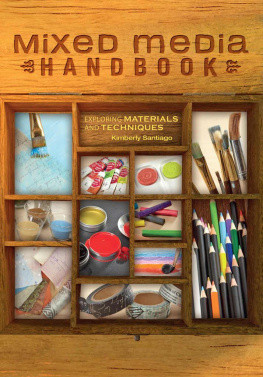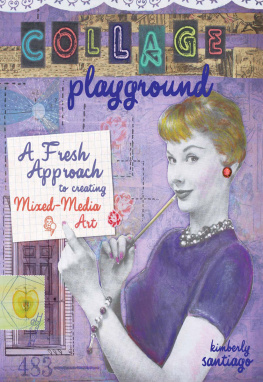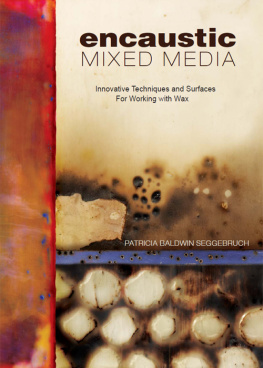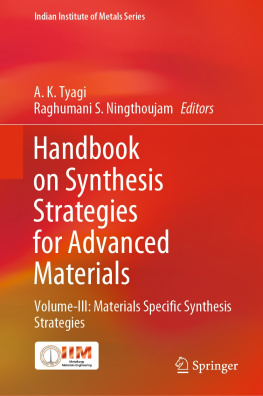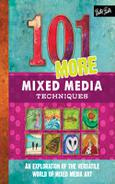Santiago - Mixed Media Handbook: Exploring Materials and Techniques
Here you can read online Santiago - Mixed Media Handbook: Exploring Materials and Techniques full text of the book (entire story) in english for free. Download pdf and epub, get meaning, cover and reviews about this ebook. year: 2015, publisher: F W Media, genre: Home and family. Description of the work, (preface) as well as reviews are available. Best literature library LitArk.com created for fans of good reading and offers a wide selection of genres:
Romance novel
Science fiction
Adventure
Detective
Science
History
Home and family
Prose
Art
Politics
Computer
Non-fiction
Religion
Business
Children
Humor
Choose a favorite category and find really read worthwhile books. Enjoy immersion in the world of imagination, feel the emotions of the characters or learn something new for yourself, make an fascinating discovery.
- Book:Mixed Media Handbook: Exploring Materials and Techniques
- Author:
- Publisher:F W Media
- Genre:
- Year:2015
- Rating:4 / 5
- Favourites:Add to favourites
- Your mark:
- 80
- 1
- 2
- 3
- 4
- 5
Mixed Media Handbook: Exploring Materials and Techniques: summary, description and annotation
We offer to read an annotation, description, summary or preface (depends on what the author of the book "Mixed Media Handbook: Exploring Materials and Techniques" wrote himself). If you haven't found the necessary information about the book — write in the comments, we will try to find it.
Exploring Materials and Techniques
Santiago: author's other books
Who wrote Mixed Media Handbook: Exploring Materials and Techniques? Find out the surname, the name of the author of the book and a list of all author's works by series.
Mixed Media Handbook: Exploring Materials and Techniques — read online for free the complete book (whole text) full work
Below is the text of the book, divided by pages. System saving the place of the last page read, allows you to conveniently read the book "Mixed Media Handbook: Exploring Materials and Techniques" online for free, without having to search again every time where you left off. Put a bookmark, and you can go to the page where you finished reading at any time.
Font size:
Interval:
Bookmark:
Handbook

Cincinnati, Ohio
artistsnetwork.com
Sign up for our newsletter and receive special offers, access to free content, and information on the latest new releases and must-have art resources! Plus, receive a coupon code to use on your first purchase from NorthLightShop.com for signing up.

or visit us online to sign up at
http://artistsnetwork.com/ebook-promo
Abbie Marie Deaner
forever 8
Mixed Media Handbook is an easy-to-use reference of art materials and their relevance in creating mixed-media art. This book is intended to provide all age groups and skill levels a comprehensive guide to understanding art materials and supplies.
Written by a professional artist, this book offers (in a logical sequence) descriptions of the materials, tools and equipment that are currently and commonly used in creating mixed-media art.
Unlike other artists handbooks, Mixed Media Handbook caters to the present-day artist. This book provides a complete and up-to-date accounting of the materials of their craft. It answers important questions for the artists so they may have the greatest possible control over their materials. It also aids in the economy of their art, by ensuring they purchase the correct materials for their needs.
The most valuable advice offered outside of this resourceful book is that you make the effort to fully understand your materials before using them in your art. Many factors can affect the outcome of a mixed-media project. Although there are no guarantees, Mixed Media Handbook can help you to eliminate doubts and gain the confidence to make comprehensive decisions when being creative.
With its vast selection of materials, media and working processes, collage provides artists with a considerable number of productive techniques. Experimentation is essential for narrowing the almost countless possibilities to workable numbers; you will need to try several ways of combining methods and techniques. Your own personal interests in working processes, kinds of materials and goals or desired outcomes will dictate your major areas of exploration. For example, if you wish to create representational images, you should know that certain papers and techniques will be more efficient than others, so you can then sidestep scores of inappropriate collage combinations. Consider style, technique, and subject matter before you make final decisions.
When you begin experimenting, try various combinations of materials and techniques on small supports. Make notes on the back of each study to record materials, processes and problems. These notes will be very helpful as you further your creative explorations.
Collage supplies tend to differ greatly among the various personal techniques that artists develop. For example, there are numerous adhesives and methods of application, however only one is needed to build a collagethe one that is most appropriate for the materials and techniques employed. The same holds true for tools, other media and finishes. Experimentation, however, can involve additional materials and personalized selections.
Although there are many avenues to develop mixed-media art, they all begin with the same simple principles: gather your resources and materials, select a substrate, edit down your collage resources, select an adhesive, begin your first layer, embellish with other media and continue to repeat until you achieve the desired look.
Once you have chosen your collage materials, you then want to develop personal techniques for using them most effectively. Again, experimentation is the key to our successful solutions and discoveries. You should try various ways of cutting, tearing, adhering, overpainting, altering and finishing until you are satisfied that you are accomplishing two things: the most effective way to use materials, and a style that is representational of you. Experimental activities can best be carried out on small studies so that many possibilities can be explored in a short period of time.


Mixed-media art comes from a plethora of different places, and knowing just where to start can be daunting. Oftentimes, an idea is sparked from an existing material: a photograph, a letter, a bit of tile or a found object. Whatever the case may be, the selection of the substrate or the base is vital to the success of the artwork. This chapter helps to clarify which types of substrates to use for various types of projects and why to use them. The information covered in this chapter will aid you in your decision-making process while providing you with a clear understanding of the materials.
There are three basic categories of substrates: board, paper and textured. When choosing your substrate, consider what materials youll be attaching and how youll be attaching them. For instance, lightweight substrates may buckle under heavy objects or if wet mediums and adhesives are used.
The surface of the substrate is also important; consider whether or not it is porous and will grab adhesives or paints. Another consideration is flexibility. For example, rubber stamping on a stretched canvas would be difficult because of the give of the canvas. A more suitable substrate for stamping would be a solid panel or board.
When deciding on your substrate, consider the following:
- What type of surface do you want to work on? Hard and rigid or soft and flexible?
- Do you want the substrate surface to be smooth, slightly textured or rough?
- Does the substrate need to be archival? Is longevity a concern? What is the material content?
- Is the size or shape of the substrate important?
- How will you be attaching or adhering collage materials to the substrate?
- How heavy are the materials?
Whatever your selection, there are always suitable adaptations, which makes mixed media an enjoyable and versatile art form.
We have discussed a variety of substrates available commercially; now lets take a look at unconventional items that can be used in mixed media.

Far left: Strathmore mixed-media board, vellum surface; Center back: Ampersand Claybord, multi-media, cradled 78" (.33cm); Upper Right: Ampersand Pastelbord, flat panels, Front Center: Ampersand Hardbord, flat panel.
Font size:
Interval:
Bookmark:
Similar books «Mixed Media Handbook: Exploring Materials and Techniques»
Look at similar books to Mixed Media Handbook: Exploring Materials and Techniques. We have selected literature similar in name and meaning in the hope of providing readers with more options to find new, interesting, not yet read works.
Discussion, reviews of the book Mixed Media Handbook: Exploring Materials and Techniques and just readers' own opinions. Leave your comments, write what you think about the work, its meaning or the main characters. Specify what exactly you liked and what you didn't like, and why you think so.

